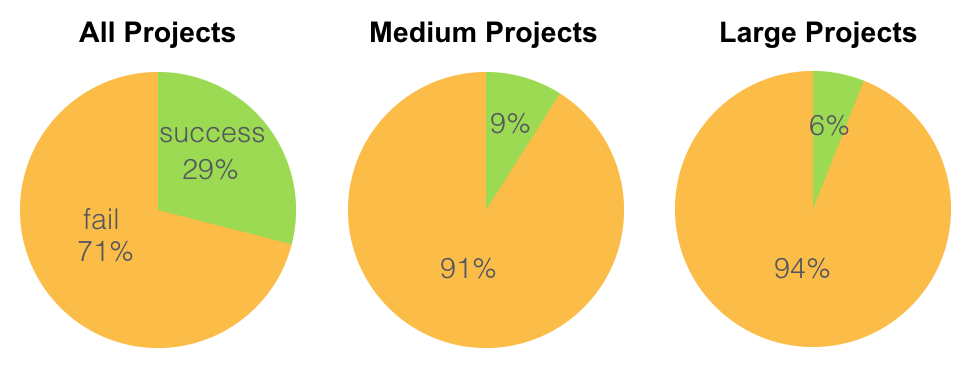Software development indeed stands as one of the most intricate production services globally, encompassing a multitude of parameters that necessitate careful consideration. The challenges inherent in this domain span various facets:
- Technical Knowledge: Developing software requires a deep understanding of programming languages, frameworks, and tools, as well as proficiency in software architecture and design principles.
- People Management: Effective collaboration and coordination among team members are crucial for successful software development. This involves managing diverse skill sets, fostering a collaborative culture, and resolving conflicts efficiently.
- Project Management: Efficient project management is essential to ensure that software projects are completed on time, within budget, and according to specifications. This includes defining project goals, creating timelines, allocating resources, and monitoring progress.
- Stakeholder Management: Engaging with stakeholders, including clients, end-users, and other relevant parties, is vital to understand their requirements, gather feedback, and ensure alignment throughout the development process.
- Scope Management: Managing project scope involves defining and controlling what is included in the software development project to prevent scope creep and maintain focus on delivering the intended features and functionalities.
- Security: With the increasing prevalence of cyber threats, ensuring the security of software applications is paramount. This includes implementing robust security measures to protect against vulnerabilities, data breaches, and unauthorized access.
- Performance: Software performance is critical to providing a satisfactory user experience. Developers must optimize code, design efficient algorithms, and conduct performance testing to ensure that applications meet performance expectations under various conditions.
- Infrastructure: Choosing the right infrastructure, including hardware, software platforms, and hosting solutions, is crucial for supporting software applications’ scalability, reliability, and availability.
In addition to these challenges, it’s imperative to continually adapt to evolving technologies, methodologies, and industry trends to remain competitive in the ever-changing landscape of software development.
The Paradox of Software Development: High Failure Rates Despite Advanced Practices
The software development landscape boasts agile methodologies, cutting-edge technologies, and sophisticated project management tools. Yet, a surprisingly high number of projects still fail to meet expectations.
Research Paints a Concerning Picture:
Studies reveal a significant failure rate across project sizes. The Standish Group’s 2015 CHAOS Report found that a staggering 71% of projects failed to deliver on time, within budget, and with satisfactory results. This figure becomes even more alarming for large projects, with a 94% failure rate according to the same report.
The financial impact is equally concerning. A 2020 CISQ Report estimates that unsuccessful development projects cost US firms a staggering $260 billion annually. Moreover, poorly-developed software contributes to an additional $1.56 trillion in operational failures.

Beyond Complete Failure:
While some projects completely fail, a significant number fall short of expectations even when technically “successful.” Project Management Institute’s 2017 report highlights this reality:
- 31% of projects didn’t meet their initial goals.
- 43% exceeded their initial budgets.
- 49% were delivered late.
Common reasons for IT project failure
- Unclear goals and a roadmap: unclear goals and a roadmap lost in confusion, ambitions that balloon the project into an unmanageable beast, and a communication chasm between stakeholders and developers. This lack of understanding breeds scope creep, unrealistic expectations, and wasted resources, leaving everyone frustrated with a subpar final product. Project discovery is the cornerstone of a successful journey. This initial phase isn’t just about brainstorming ideas; it’s about deep exploration. By thoroughly examining project goals, user needs, technical feasibility, and potential risks, project discovery lays the groundwork for a clear and well-defined roadmap. This shared roadmap acts as a compass, guiding both developers and stakeholders towards a common vision. By fostering open communication and aligning expectations during discovery, the project avoids costly misunderstandings and scope creep down the line, ensuring everyone is invested in building a solution that truly delivers.
- Poor Planning and Monitoring: Just like building a house needs a blueprint to avoid delays and wasted materials, projects require meticulous planning – outlining scope, timelines, resources, and risks. Without this foundation, projects are prone to missed deadlines, budget overruns, and scope creep. However, planning isn’t a one-time event. Continuous monitoring progress against the plan allows for course correction, resource optimization, and adaptation to changing realities. It’s this marriage of thorough planning and ongoing monitoring that paves the way for successful project completion.
- Communication Issues: A common paradox plagues software development – teams with brilliant minds can struggle to deliver. Often, the culprit isn’t technical incompetence; it’s a breakdown in communication. Imagine a team of expert programmers working independently, like islands in an archipelago. Each might write exceptional code, but without clear communication about dependencies and functionalities, those pieces won’t integrate seamlessly. Features developed in isolation may be technically sound, but when combined, they create a dysfunctional whole. This lack of communication leads to constant sprint failures, missed deadlines, and ultimately, project failure. Addressing these communication silos is key to unlocking a team’s true potential and achieving project success.
- Lack of Resource Management: Not having the right people with the necessary skills or having inadequate resources like budget or time can significantly hinder a project’s progress. Assigning unqualified personnel or unrealistic deadlines sets the project up for failure.
- Lack of Stakeholder Buy-In: If key stakeholders are not invested in the project’s success, they may not provide the necessary support or resources. This can lead to resistance to change and difficulty in making decisions.
- Scope Creep: This occurs when the project’s scope of work continues to grow without a corresponding increase in resources or budget. This can lead to missed deadlines, budget overruns, and a decline in quality as features are rushed or sacrificed.
- Poor Risk Management: Failing to identify and plan for potential risks can leave projects vulnerable to unforeseen challenges. These challenges can be technical issues, security breaches, or external factors like economic downturns, all leading to delays, disruptions, and additional costs.
- Inadequate Change Management: The inability to effectively manage changes to the project scope, timeline, or budget can lead to confusion, frustration, and resistance within the team. A rigid approach to change can stifle innovation and make it difficult to adapt to evolving needs.
- Lack of User Involvement: Not involving users in the design and development process can lead to a product or service that does not meet their needs. User feedback is crucial for ensuring the final product is relevant, intuitive, and valuable.
- Unrealistic Expectations: Setting unrealistic expectations for the project’s scope, timeline, or budget can set the project up for failure from the start. Unrealistic expectations lead to pressure, shortcuts, and ultimately, disappointment.
- Micromanagement: Overly controlling the project and stifling the team’s creativity can lead to decreased morale, inefficiency, and missed opportunities. Trusting your team and fostering a collaborative environment is essential for success.
- Poor Team Dynamics: A team with conflicting personalities, poor communication skills, or a lack of trust can struggle to work together effectively. Fostering a positive team culture and resolving conflicts is crucial for optimal performance.
- Burnout: Team members who are overworked and under-resourced can become burned out, leading to decreased productivity, errors, and high turnover. Maintaining a healthy workload and promoting work-life balance is essential.
- Technical Issues: Unforeseen technical challenges can cause delays and disruptions. Staying updated on the latest technologies and having contingency plans are vital for smooth development.
- External Factors: Events outside of the project team’s control, such as natural disasters, economic downturns, or pandemic outbreaks, can also contribute to project failure. Building flexibility and adaptability into project plans can help navigate unexpected circumstances.
- The Hidden Costs of Inadequate QA: Skimping on quality assurance (QA) is a false economy. Without thorough testing, both automated and manual, hidden defects and security vulnerabilities can slip through the cracks, leading to crashes, data breaches, and frustrated users. Fixing these issues after launch is far costlier than catching them early through robust QA. A balanced approach that leverages automated efficiency and human expertise ensures a high-quality product from the start, saving time, and money, and protecting your reputation.
- constantly change team members and team size: A well-oiled machine thrives on consistency, and software development teams are no exception. The allure of mitigating risk by swapping team members with fresh perspectives or accelerating development with a sudden influx of new talent can backfire. These constant fluctuations in team size and composition disrupt the flow of knowledge transfer. New members require time to understand the project’s intricacies, while those departing take valuable context with them. This disrupts communication, weakens collaboration, and ultimately, hinders progress. Instead of a streamlined solution, it creates a revolving door of on-boarding and off-boarding, jeopardizing project momentum and morale. Building a stable team with clear communication channels fosters a deeper understanding of the project, leading to more efficient risk management and a higher likelihood of success.
- Lack of documentation: The lack of documentation within a project or organization can be a significant obstacle to its success. Documentation serves as a crucial resource for capturing and preserving institutional knowledge, processes, and best practices. Without adequate documentation, team members may struggle to understand how systems work, troubleshoot issues efficiently, or onboard new members effectively. This can lead to increased errors, delays in project timelines, and frustration among team members. Moreover, the absence of documentation can pose significant risks in terms of compliance, security, and continuity, especially during transitions or unexpected events. Investing time and effort into creating comprehensive and accessible documentation is essential for fostering transparency, collaboration, and long-term success within any organization or project.
- A poor project structure and architecture: A poor project structure and architecture can be detrimental to the success and scalability of a software project. Rather than focusing on complexity, it’s crucial to prioritize creating a clean and clear structure that fosters collaboration and consistency across all teams. Implementing robust code review processes ensures that all contributions adhere to the same standards and guidelines, promoting cohesion and maintainability. Additionally, designing an architecture that allows for easy scalability in the future is essential. While it’s tempting to over-engineer and plan for extensive growth, it’s more practical to focus on building an MVP (Minimum Viable Product) that meets current needs and can be extended incrementally as requirements evolve. This approach avoids unnecessary complexity and ensures that the platform remains adaptable to changes and user growth over the next one to two years without sacrificing stability or performance.
- Lack of Continuous Improvement: Continuous improvement is often hindered by the pressures developers face, leading to the implementation of subpar or hastily constructed solutions. Consequently, we find ourselves needing to rectify these shortcomings in the future. Additionally, valuable lessons learned from one aspect of a project may necessitate adjustments in other areas. Therefore, dedicating specific time to ongoing improvement and refinement is crucial to ensure the final product maintains a high level of quality.
- Not Focus on Core Needs: While it’s tempting to cater to every user imaginable, successful software prioritizes core functionality. Trying to please everyone at once leads to feature bloat, a product that’s complex, resource-intensive, and difficult to maintain. Instead, focus on solving a specific problem for a well-defined user group. This targeted approach results in a leaner, more efficient product that delivers exceptional value to its core audience. Future versions can then introduce additional functionalities that complement and build upon the core offering.

